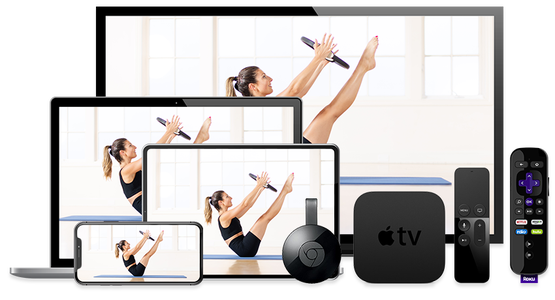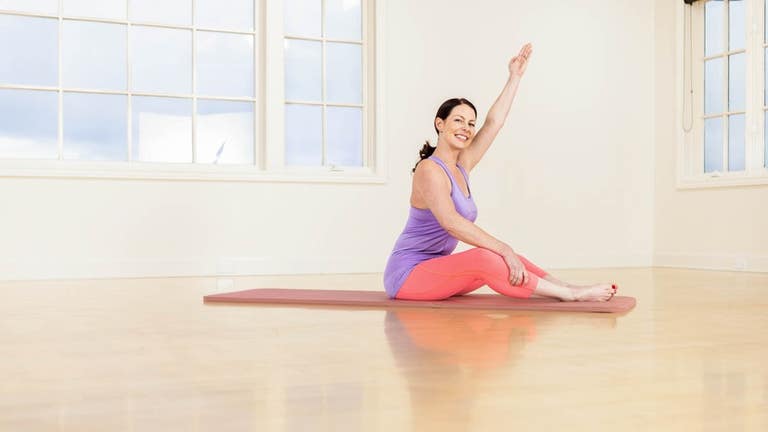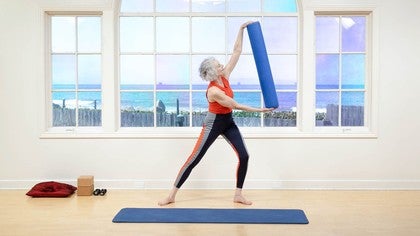Beginner Pilates for Seniors

Defying Age With Versatility
You are never too old to begin your Pilates practice. If you are 60+ years and active, you are ready to start! If you have any pre-existing conditions or have not been active for a while, we recommend you consult with your doctor before beginning any new exercise. It's never too late to learn to move your body more efficiently and with Pilates, you can regain your strength, flexibility, and mobility. Remember, take your time. Pilates requires focus, attention, deliberate movement, and staying aware of your body. Err on the side of caution, slow down, and modify exercises as needed. By practicing regularly, you will begin to feel the positive impact of Pilates.
Benefits of Pilates for Seniors
Pilates is wonderful for everybody at any age. Seniors, in particular, can really benefit from a Pilates practice. You may have noticed changes in your balance, strength, flexibility, focus, and your breath are all areas you may notice have changed with age. Pilates at its core works on improving all of those things! Pilates is gentle enough to be right for you at any age and every exercise can be modified to meet you where your body is that day.
Tips and Advice for Seniors
Practicing beginner Pilates at least twice a week is enough to notice a difference in your strength, flexibility, and balance. If you feel great and love your Pilates practice from the start, feel free to add a third day to your weekly routine. Listening to our bodies is sometimes something we have to relearn as we grow up. Remember that our bodies show up for us differently each day. This is true of children, teenagers, young adults, a forty-year-old, and even you. Allow Pilates to do its job for your body by meeting it wherever it is on any given day.
Pilates for Round Back
Pilates Exercises for Seniors
Seniors will benefit from both Mat Pilates and Reformer Pilates sessions. Initially, you may want to take a few private classes with a trained Pilates teacher to help you become comfortable with the exercises and modifications. Mat classes are often more available and less expensive than Reformer classes, but both offer community via classmates of all ages. If you have specific goals you would like to achieve, you may enjoy personalized private sessions. Once you are comfortable with the basic Mat Pilates exercises, you can stream a class or practice from notes you've taken at home. Some great Pilates Mat exercises for seniors include the Single Leg Pull, Double Leg Pull, Side-Lying Series, Clam, Modified Plank, Chest Expansion, Leg Slides, and Thigh Folds.
Chair Pilates for Seniors
Pilates can begin with a series practiced just sitting in a Chair! We recommend a straight chair with feet easily touching the ground, but even Chair Pilates can be modified for those who find stiff Chairs too much of a challenge. Your Chair routine may just begin with arranging yourself to be in alignment in the Chair, which means your feed are fist-width apart, your glutes spread out so that you are on your sitz bones, squeezing your butt to feel yourself "pop" up within your spine, and using your lower abdominals to support your back. Next, you can practice the Arm Series (Hug a Tree, Back Rowing/Sitting Lats, the entire Standing Arm Series), Spine Twist (modified and avoided with osteoporosis), and leg extensions/adductor squeezes.
Featured Classes for Seniors
Our class selection includes Mat, Reformer, Magic Circle, Osteoporosis Safe, and more.
Precautions and Modifications
For Seniors with Osteoporosis
Pilates is great for seniors with osteoporosis, but a traditional Mat Pilates class is ill-advised. Many of the Mat exercises can be modified for safety for someone with osteoporosis, but the Roll Up, Roll Over, Jack Knife, Spine Twist, and Saw should not be practiced. You want to steer clear of any exercises involving bending forward, rolling on your back, and twisting at the spine. In general, it is a great idea to find a Pilates teacher who has knowledge of the do’s and don'ts of Pilates for osteoporosis and take a class or private session with her first. Try some of our osteoporosis-safe classes.
For Seniors with Limited Range of Motion
One of the best things about Pilates is that it will meet your body wherever it is today. If you have limited range of motion, you can modify your practice to accommodate your range of motion. Do not try to force any movement. We recommend moving more slowly and deliberately, using your breath to help you. Often the best work even for a young athlete is the work done within a very small range of motion, so consider yourself an Olympian and work within your range!
For Seniors with Arthritis
Seniors with arthritis or other joint issues will benefit from a Pilates practice. However, progress may be slow and it is important to avoid or modify exercises that tire or strain joints. Some of the exercises to avoid are the Roll Over, Jack Knife, Spine Twist, and Rolling Like a Ball. Remember that one of the key components of Pilates is awareness and focus. Pay attention to your movement and how you feel before, during, and after your Pilates exercises. Don't do anything that feels stressful to your spine or joints. You can set yourself up for success by working with a trained Pilates teacher who has taken coursework in Pilates for arthritis and joint issues.
To Avoid Injury
Senior Pilates students are often much better at responding to messages from their bodies than young adults. This is because younger adults often ignore messages or pain signals from our bodies, opting to "push through" something before they are ready. Always prioritize safety in your Pilates practice. A good teacher will encourage you to slow down, move in a smaller range of motion, and offer exercise modifications. Ask for help and schedule a few private sessions with a trained Pilates teacher. If an exercise hurts, stop doing it immediately. Listening to your body is a big part of being a Pilates student.
Senior Pilates Frequently Asked Questions
Should you find private instruction?
Private sessions with a trained Pilates teacher is a great start to anyone beginning a Pilates practice. For a senior beginning a new exercise or wellness routine, private sessions with a Pilates teacher who is comfortable with modifying exercises for senior bodies is your best route to success. Opting for private sessions over a large group class will allow you to become comfortable with the fundamental Pilates exercises and modifications for your body.
Is Pilates good for balance?
Pilates is an excellent choice for improving and maintaining your balance! Because Pilates works on balancing muscles, you will evenly build strength and flexibility on both sides of your body while training small and large muscle groups alike. In addition, good core strength is essential to physical balance. Pilates is an excellent way to build strength to support posture and alignment.
What to do if you feel pain?
If you feel pain or discomfort during your Pilates session, stop whatever you are doing right away. If you are capable of being on the floor when you practice Pilates (versus in a chair), place yourself in a neutral spine position with knees bent, feet on the floor, and allow your body to rest with the help of gravity. Then, check with your doctor before you continue to do Pilates. If you feel like you've worked your muscles in a good way, keep moving. Your Pilates practice is designed to avoid pain or injury. Be your best advocate for safety and moderation.
Can Pilates help prevent falls?
Pilates is great for improving balance, strength, and confidence in how we move, which in turn can help prevent falls. We recommend working with a Pilates teacher who has experience with seniors and fall prevention to ensure your practice will set you up for success! Take a look at some of our Fall Prevention Strategies.
Your Pilates Anytime Membership Benefits

- 15-Day Free Trial
- Unlimited Access to Thousands of Classes
- 95+ Pilates Programs and Challenges
- No Ads
- New Videos Weekly
- Available on All Your Favorite Devices









